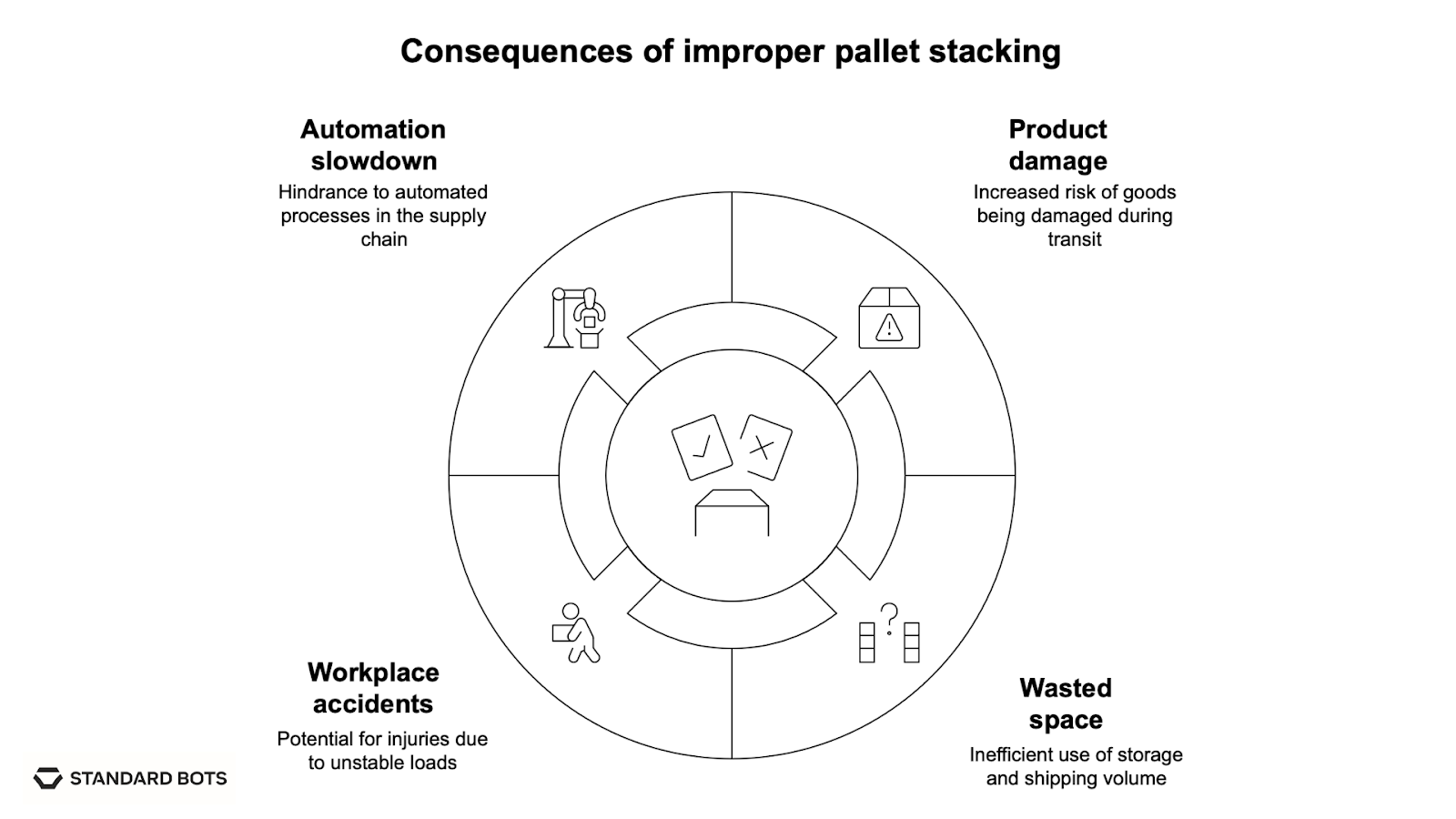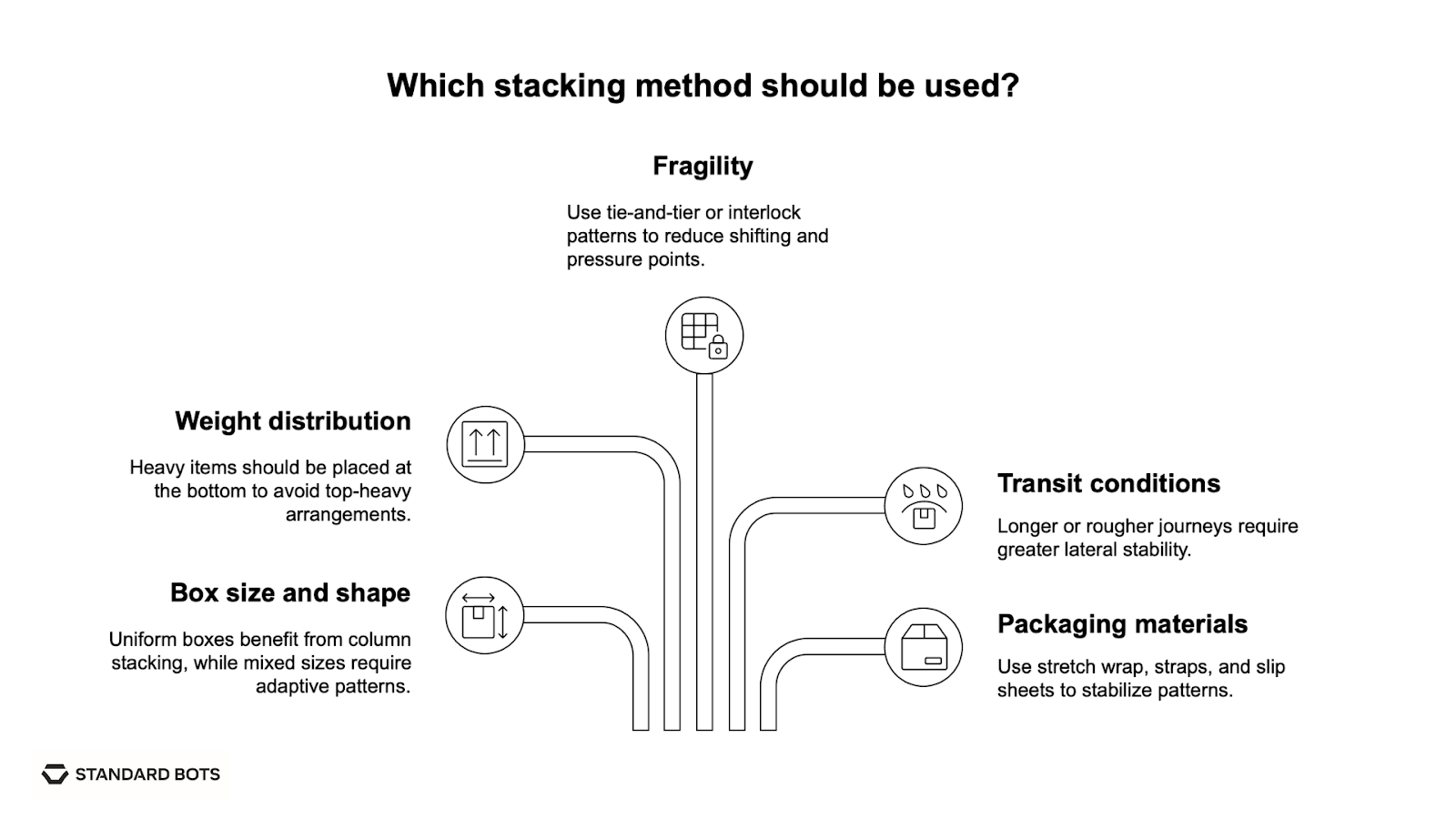Pallet stacking patterns are the foundation of safe, efficient warehouse operations.
Essential pallet stacking patterns include column stacking for height with uniform boxes and interlocking for stability during transit. Pinwheel stacking provides greater stability, and custom mixed stacking handles irregular items with flexible, often software-assisted layout optimization.
The way you arrange boxes on a pallet affects product stability, trailer space, and damage risk in transit. According to Packaging Digest, poor stacking causes up to 11% of product damage during shipping. It also slows down loading and wastes fuel.
What are pallet stacking patterns?
Pallet stacking patterns are the various ways to arrange items on a pallet to maximize stability, space utilization, and ease of handling during storage and transportation. These patterns are crucial for efficient inventory management and logistics.
If you’re new to the term, check out our quick overview of what palletization means.
Why they matter:
- Improper stacking increases product damage from shifting loads or collapse
- Wasted space leads to higher shipping costs and underused trailer volume
- Inconsistent stacks slow down automation and handoffs across the supply chain
- Unstable pallets can cause workplace accidents and violate OSHA safety standards
Understanding and applying the right stacking pattern helps streamline operations and prevent these avoidable issues.

Types of pallet stacking patterns
Visual cheat sheet: Pallet stacking patterns at a glance
1. Column stacking (block stacking)
Column stacking means placing boxes directly on top of one another in straight lines. Each box sits perfectly above the one below it, forming a tall, clean tower, almost like stacking bricks for a photo shoot. It’s quick, tidy, and works best when all your boxes are the same size and shape. If your goal is to go high without tipping over, this is the pattern to use.
Use when:
- Boxes are uniform in size
- Maximum vertical stacking is desired
- The load is unlikely to shift during handling or transit
Pros:
- Quick and simple to execute
- Excellent height and volume use
Cons:
- Not ideal for uneven or mixed loads
- Less lateral stability, hence more prone to tipping or shifting
A common debate is column stacking vs. interlock stacking, especially when deciding between simplicity and stability.
Exercise caution when stacking pallets on top of each other using this method, as column stacks may compress under heavy weight.
2. Interlocking stack pattern
Interlocking stacking arranges each box layer in alternating directions, similar to building a brick wall. Instead of lining everything up, you offset the boxes slightly so that one row supports the next. This crisscrossing helps lock the load together and reduces the chances of boxes sliding around mid-transit.
Use when:
- The load needs to resist shifting from side to side
- Shipments experience long transit routes or vibration, or frequent handling
Pros:
- Boxes support each other across layers
- Stronger lateral stability than column stacking
Cons:
- Slightly reduces vertical strength
- May introduce small gaps between boxes
- Takes more time to assemble than column stacks
Pro tip: If you’re shipping products over bumpy roads or handing them off multiple times, this pattern offers a good balance of stability and speed.
3. Pinwheel or chimney stack pattern
Pinwheel stacking arranges boxes with their corners turned toward the center, creating a spiraling, pinwheel-like pattern when viewed from above. This pattern is also known as chimney stacking, and it’s great when you’re working with heavy, dense items that need serious compression strength.
Use when:
- Airflow or center support is beneficial
- Heavy or compressive loads like bricks, cement, or building materials
Pros:
- Excellent vertical compression strength
- Load perimeter provides structure and balance
Cons:
- Slower to assemble manually
- Inefficient in terms of space usage
The chimney stack pallet pattern is ideal when working with pallets in construction or raw materials industries. You can also use this pattern or setup for specific items that tend to move around during shipping, such as irregular or cylindrical containers.
4. Custom mixed-size stacking (adaptive patterning)
Custom mixed stacking is what you use when no single pattern fits, literally. It’s a flexible, hybrid approach that combines multiple stacking methods to accommodate boxes of different sizes, weights, or shapes. Think of it as puzzle-solving for warehouse pros.
You might start with interlocking layers at the bottom, place lighter boxes toward the top, and fill awkward gaps with corner boards or void fillers. Some warehouses even use vision systems or WMS software to calculate the best layout on the fly.
Use when:
- Orders are picked per customer, not bulk-packed
- Dealing with diverse product SKUs or irregular box sizes
- Warehouses with custom orders or direct-to-consumer fulfillment
Pros:
- Flexible for e-commerce, retail, and fulfillment centers
- Allows for maximum pallet utilization when paired with software
Cons:
- Manual stacking is time-consuming and inconsistent
- Often requires warehouse software or automation for efficiency
- May require void fillers, corner boards, or other stabilizing materials
When this pattern works best:
If you’re wondering how to stack a pallet with different-sized boxes, this method is your go-to. It often works best when assisted by robotic palletizers like a cobot palletizer or integrated warehouse management tools.
Choosing the right stacking pattern: Factors to consider

Selecting a stacking method depends on your operation's priorities and constraints.
Here are some factors to evaluate:
- Box size and shape: Uniform products benefit from column stacking; mixed sizes require adaptive patterns
- Weight distribution: Heavy items should go on the bottom; avoid top-heavy arrangements
- Fragility: Use interlocking patterns to reduce shifting and pressure points
- Transit conditions: Longer or rougher journeys call for greater lateral stability; long distances or frequent handling favor interlock patterns
- Packaging materials: Stretch wrap, straps, and slip sheets help stabilize many patterns
Note: There's a difference between stacking pallets (storage strategy) and stacking boxes on pallets (loading strategy). Storage strategy focuses on overall load handling, while loading strategy addresses how to build the stack effectively. Choose patterns that support both.
Real-world stacking examples
FMCG and e-commerce
Major e-commerce operators like Amazon use automation and interlocking-style pallet stacking to handle high-variation and high-volume orders.
Amazon, through its acquisition of Kiva Systems, implemented robotic systems to help build stable pallets quickly, especially during high-volume shipping seasons. Quiet Logistics integrated robotics early on to support mixed carton workflows, reducing product damage and enhancing carton stability in transit.
Beverages and pharmaceuticals
These industries often ship products in uniform packaging, like bottles or cartons. That’s why they mostly use column stacking, which works well for maximizing space and stacking strength in storage racks. The method ensures product shape integrity and maximizes vertical load capacity.
JD.com, a major Chinese e-commerce company, uses automated systems to build pallets with consistent box sizes. This helps stack tall, secure pallets quickly in its smart warehouses.
Construction and building supplies
For heavy goods such as bricks, tiles, and cement bags, companies in the construction supply chain often use the chimney stack pattern for superior compression resistance. Equipment suppliers also emphasize pallet containment and secure strapping designed specifically for masonry products to reduce breakage and stabilize heavy loads during transport.
In construction-focused logistics, manufacturers and packers of dense materials leverage the natural compressive strength of chimney stacking to prevent damage under heavy pallet loads.
Common stacking mistakes to avoid
Even with the right pattern, simple mistakes can lead to damaged loads or unstable pallets.
- Do not place heavier boxes on top: This increases the risk of tipping or collapse and should always be avoided.
- Avoid poor box alignment: When edges or corners don't line up properly, the entire stack becomes weaker, particularly when using column or interlocking patterns.
- Do not use mixed box sizes without a clear plan: Random combinations of different-sized boxes often cause instability and compromise the structural integrity of the pallet.
- Do not skip essential securing materials: Failing to use shrink wrap, slip sheets, or corner boards allows loads to shift during transit, leading to damage.
- Do not use inconsistent stacking practices: Not following standardized procedures leads to repeated errors and unreliable results.
Key recommendations:
Just stay consistent, and teach your team to follow clear stacking rules every time. Or explore automation if you want fewer errors and more reliable results.
Applying these patterns in your warehouse
Each stacking pattern in this guide solves a specific problem. Column stacks help you go vertical when every inch matters. Interlocking layers improve stability when boxes get bumped or jostled. And custom mixed patterns shine when you are dealing with different box sizes or unique order mixes.
The key is to match the stacking method to your load type, shipping conditions, and available equipment. If your operation is growing, or you are working with lots of different SKUs, manual stacking may not be enough.
By using these four patterns and knowing when to bring in automation, you can reduce product damage, speed up order processing, and keep your warehouse running efficiently.
Ti-Hi calculations: Getting the pallet math right
Ti-Hi (Tie-High) is the standard method for calculating how many items fit on a pallet. Ti refers to the number of boxes/cartons stored on a layer, or tier, and Hi refers to the number of layers high that these will be stacked on the pallet.
How Ti-Hi works:
- Ti (Tie): Number of cases per layer on the pallet
- Hi (High): Number of layers stacked vertically
For example, if you can fit 12 boxes per layer and stack 6 layers high, your Ti-Hi is 12 x 6 = 72 total boxes per pallet.
Calculating Ti-Hi:
- Measure your product dimensions (length, width, height)
- Measure your pallet dimensions
- Calculate Ti: Divide pallet length/width by product length/width
- Calculate Hi: Divide the maximum pallet height by the product height
Proper Ti-Hi counting ensures that pallets are stable during transportation, minimizing the risk of damage to goods. Getting these calculations right maximizes space utilization, reduces shipping costs, and prevents overhang issues that can compromise load stability.
Many businesses use pallet calculators or software to optimize Ti-Hi configurations for different product combinations.
How to program your palletizing robot: Step-by-step setup
Programming RO1 for palletizing is surprisingly straightforward thanks to its no-code interface.
- Step 1: Define your pallet pattern. Use RO1's touchscreen to select your box dimensions and pallet size. The system automatically generates optimal stacking patterns to maximize stability and space efficiency.
- Step 2: Teach pickup and drop points. Guide RO1's arm to the product pickup location using the intuitive drag-and-teach method. Then show it where to place the first box on the pallet. RO1 learns these positions instantly.
- Step 3: Set gripper parameters. Configure suction pressure or gripper force based on your product weight and material. RO1's built-in sensors automatically adjust grip strength to prevent damage.
- Step 4: Program safety zones. Define areas where RO1 should slow down or stop if operators are present. The collaborative design means no safety caging, but clear boundaries keep everyone safe.
- Step 5: Test and optimize. Run a few cycles manually, then switch to automatic mode. RO1's AI continuously learns and improves cycle times while maintaining precision.
Is your warehouse ready for automated pallet stacking?
Manual pallet stacking struggles to keep up with growing SKU complexity and shipping demands.
If your team is frequently dealing with:
- High SKU complexity
- Product shifting during shipping
- Inconsistent manual pallet loads
Well … it might be time to automate.
Modern cobots like the RO1 palletizer use built-in vision and smart algorithms to analyze each box’s size and choose the most stable stacking pattern, on the fly. They reduce human error, increase consistency, and adapt to mixed product loads with ease.
Want to go further? Explore how to choose the right robotic arm for your palletizing workflow.
Next steps with Standard Bots’ robotic solutions
Looking to upgrade your automation game? Standard Bots’ RO1 is the perfect six-axis cobot addition to any palletizing setup, delivering unbeatable precision and flexibility.
- Affordable and adaptable: RO1 costs $37K (list). Get high-precision automation at half the cost of traditional robots.
- Precision and power: With a repeatability of ±0.025 mm and an 18 kg payload, RO1 handles even the most demanding CNC jobs.
- AI-driven simplicity: Equipped with AI capabilities on par with GPT-4, RO1 integrates seamlessly with CNC systems for advanced automation.
- Safety-first design: Machine vision and collision detection mean RO1 works safely alongside human operators.
Schedule your on-site demo with our engineers today and see how RO1 can bring AI-powered greatness to your shop floor.
FAQs
1. How high can you stack a pallet safely for shipping?
You can safely stack a pallet up to 60 to 72 inches high, depending on box stability and load distribution. Exceeding this height increases the risk of tipping and may violate OSHA safety guidelines.
2. Can pallets be double-stacked in a truck or warehouse?
Yes, pallets can be double-stacked if the bottom pallet can bear the weight without collapsing. Column or tie-and-tier stacking is recommended for better load support.
3. What is chimney stacking, and when should I use it?
Chimney stacking creates a hollow center by rotating box corners inward on each layer. It’s ideal for compressive loads like bricks or cement bags that benefit from vertical pressure resistance.
4. How do I stack a pallet when my boxes are different sizes?
To stack a pallet with different-sized boxes, you can use a custom mixed-size stacking pattern. Automation tools or WMS software often calculate the safest and most space-efficient layout for these cases.
5. Is there software that helps create pallet stacking patterns?
Yes, the software that most warehouse management systems and palletizing robots use include built-in stacking logic. These tools evaluate box size, weight, and load rules to build optimized patterns automatically. Standard Bots' RO1 includes built-in vision and stacking logic that automatically optimizes pallet patterns based on box dimensions and weight.
6. What is the maximum weight a standard pallet can hold without risk?
The maximum weight a standard pallet can hold without risk is between 2,500 and 3,000 pounds. This depends on the pallet's construction and how evenly the load is distributed across its surface.
Join thousands of creators
receiving our weekly articles.












